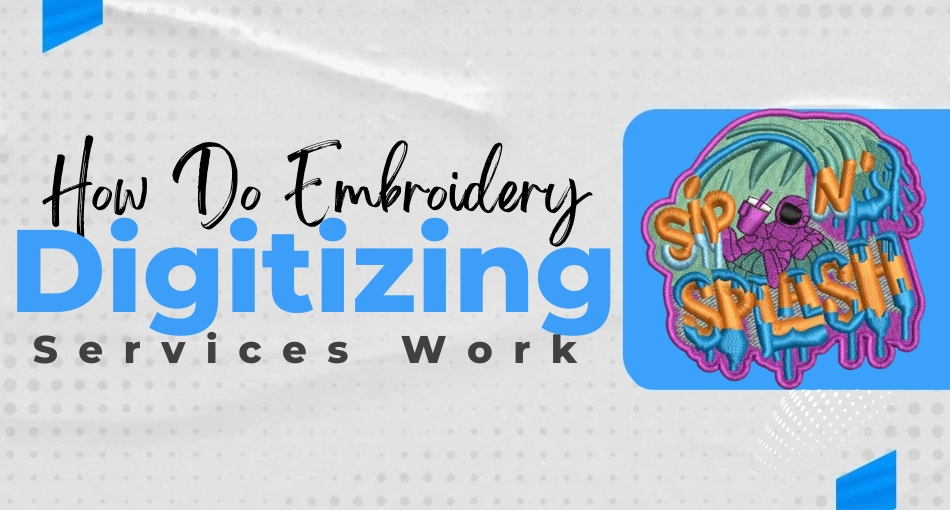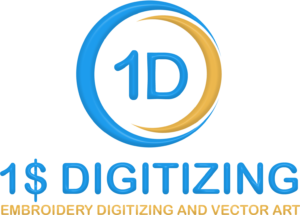Embroidery digitizing is a crucial process that transforms intricate designs into stitch files, enabling seamless machine embroidery. As the demand for customized embroidery continues to rise across various industries, understanding how embroidery digitizing services work becomes essential for businesses and hobbyists alike. This article will explore the fundamentals of embroidery digitizing, detailing the step-by-step process, the tools and software involved, and the factors that influence the cost of these services. Additionally, we will guide you on how to choose the right service provider and address common challenges faced during the digitizing process. Whether you are looking to create branded merchandise or personal projects, this comprehensive overview will equip you with the knowledge to navigate the world of embroidery digitizing effectively.
What is Embroidery Digitizing?
Embroidery digitizing is the magical process that transforms your favourite designs, logos, or artwork into a format that embroidery machines can understand—think of it as translating your design into “machine speak.” It involves carefully converting the design so that the embroidery machine knows exactly where to stitch, how tight to pull the thread, and when to switch color. In simpler terms, it’s like writing a love letter, but instead of words, you’re expressing creativity through stitches!
Importance of Digitizing in Embroidery
Why bother with digitizing, you ask? Well, imagine trying to bake a cake without a recipe; it could end up a delicious disaster! The same goes for embroidery. Digitizing is crucial for ensuring that your designs come out looking polished and professional. Properly digitized designs not only reduce the chances of thread tangling or breaking but also help maintain the integrity of your design, ensuring it looks fabulous on fabric. So, whether you’re a small business or just a crafty individual, investing in quality digitizing services is a no-brainer!
Initial Design Preparation
Every masterpiece begins with a sketch, right? The same holds true for embroidery. The initial design preparation is where the magic starts—designers gather all necessary materials and resources, like images or logos, and prepare them for digitization. This may include resizing the design, choosing the right color, and selecting the fabric type. Essentially, it’s like picking the perfect frame for your artwork before hanging it on the wall.
Converting Designs into Digital Format
Next, it’s time to convert that beautiful visual into a digital format. This usually involves tracing the design using specialized software, where every curve and line is translated into a series of commands for the embroidery machine. It’s like turning a Picasso into a pixelated masterpiece, where every detail is key to achieving that stunning final look.
Editing and Refining the Design
Once the design is in digital form, it’s time for a little makeover! The editing and refining stage involves tweaking every stitch and layer to ensure it looks just right. This might mean adjusting stitch density (because nobody likes a floppy design), testing color choices, or even simplifying overly complex designs. Think of it as giving your design a spa day—out with the rough edges, in with the fabulous!
Creating the Stitch File
Finally, we arrive at the pièce de resistance—the creation of the stitch file. This is where all the hard work culminates in a format that the embroidery machine can read, typically in file types like. DST or. EMB. The stitch file contains all the necessary information—like the order of color and stitch types—allowing the machine to replicate the design flawlessly. It’s like the instruction manual for your machine, ensuring your design comes to life without any hiccups.
Tools and Software Used in Digitizing
Overview of Popular Digitizing Software
When it comes to embroidery digitizing, the right software can make all the difference. Some popular programs include Wilcom, Hatch, and Bernina Art Link. Each offers unique features, user-friendly interfaces, and varying levels of complexity—perfect for everyone from beginner hobbyists to seasoned pros. Think of it as picking your weapon of choice for battle on the creative front!
Hardware Requirements for Digitizing
While software is essential, let’s not forget about the hardware! For optimal performance, a good computer with enough RAM and a speedy processor is a must. You’ll also want a high-resolution monitor so you can see every detail of your design clearly. It’s like needing the right tools in a kitchen—nobody wants to use a dull knife when chopping veggies, right?
Features to Look for in Digitizing Tools
Not all digitizing tools are created equal! When hunting for the right software, look for features like automatic digitizing options, stitch simulation, and easy-to-use editing capabilities. Also, keep an eye out for compatibility with your embroidery machine. You wouldn’t want to lock horns with a tool that just doesn’t want to play nice!
Different Types of Embroidery Files
Common File Formats Explained
Embroidery files come in various formats, each serving a specific purpose. Some common formats include. DST (a favourite among many machines), EXP, and. PES. Each format offers different functionalities, and familiarity with them can help you choose the best one for your project. It’s like knowing the difference between a JPEG and a PNG—each has its perks, but you want the one that’s right for the task at hand.
Differences Between Vector and Raster Files
Not all files are created equal—especially when it comes to vector and raster files. Vector files are made up of lines and curves (think of them as superheroes of scalability), allowing you to resize without losing quality. On the other hand, raster files are pixel-based and can become blurry if resized too much. For embroidery, vector files are often preferred, ensuring crisp and clean designs every time.
Compatibility with Embroidery Machines
Compatibility is key in the world of embroidery! Not every file format plays well with every machine—some machines are finicky eaters, requiring specific file types. Before you send your design off to the sewing machine, double-check that your chosen format matches your machine’s requirements. A little compatibility check can save you from a lot of thread-pulling frustration later on!
And there you have it, the ins and outs of embroidery digitizing! Now you’re armed with the knowledge to embark on your digitizing journey, whether you’re looking to create custom apparel or simply want to express your artistic flair. Happy stitching! How Do Embroidery Digitizing Services Work?
Factors Influencing the Cost of Digitizing Services
When you find yourself in need of embroidery digitizing services, your wallet might be the first thing you worry about. Let’s break down the factors that can influence the price, so you’re not left scratching your head (or your pocketbook).
Complexity of the Design
When budgeting for vector art, consider the complexity of the design, the involvement level of the artist, and the intended use of the work of art. Also, factor in any potential costs for corrections or extra administrations, such as expedited delivery. Setting a clear budget will assist you in finding the correct benefit that meets your needs without overspending.
Stitch Count and Size
Stitch count is the number of stitches that will make up your design. Imagine creating a massive mural versus a tiny doodle; it’s obviously going to take more time and resources for the mural. Larger designs with a high stitch count are understandably pricier. This means that if you want to turn your family reunion picture into an oversized embroidered patch, you’d better bring out that credit card!
Turnaround Time and Urgency
Like pizza delivery, the quicker you want it, the more it will cost you. If you need your design digitized at lightning speed (think: tomorrow morning), be ready to pay a rush fee. Most digitizing services have standard turnaround times, but if you want your project whipped up faster than a caffeine-fuelled squirrel, expect your costs to rise. It’s your call: waiting or paying for speed?
Conclusion: The Future of Embroidery Digitizing Services
As we wrap up this embroidery adventure, it’s clear that what lies ahead for digitizing services is exciting like a colourful thread waiting to be woven into an intricate design.
Trends in the Industry
The embroidery digitizing world is evolving, with trends leaning towards customization and personalization. From unique designs to niche markets, the future is bright for those who want to stand out with their embroidered creations. If there’s one thing people love, it’s a bit of flair that sets their garments apart.
Innovations in Technology
Technology is revolutionizing the digitizing process. Advanced software and machine learning are paving the way for better quality and faster turnaround times. Soon, we might be able to upload designs directly from our minds—okay, maybe that’s a bit far-fetched, but you get the idea.
The Growing Demand for Customization
Finally, let’s not overlook the increasing demand for custom embroidery services. People want their personalities stitched into the fabric of their clothes—and businesses are eager to accommodate that. So, whether you’re looking to personalize your wardrobe or create branded merchandise, the digitizing services will be right there to help you make it happen. Here’s to the future of embroidery—may it be ever colourful and creatively fulfilling! In conclusion, embroidery digitizing plays a vital role in bringing designs to life through the art of machine embroidery.
understanding the digitizing process
By understanding the digitizing process, tools, and factors that influence the cost, you can make informed decisions when selecting a service provider. As technology continues to evolve, the possibilities for customization and creativity in embroidery are expanding. Whether for business or personal use, investing in quality digitizing services will ensure your designs are executed with precision and flair. Embrace the world of embroidery digitizing and unleash your creativity!
Frequently Asked Questions (FAQs)
- What is the average turnaround time for embroidery digitizing services?
The average turnaround time for embroidery digitizing services can vary based on the complexity of the design and the service provider’s workload. Generally, it ranges from 24 hours to a few days. However, urgent requests may be accommodated for an additional fee.
- Can I use my own design for embroidery digitizing?
Absolutely! Most embroidery digitizing services allow you to submit your own artwork or design files. Just ensure that the design is in a compatible format and of high quality to achieve the best results.
- What file formats do I need for embroidery digitizing?
Common file formats accepted for embroidery digitizing include JPEG, PNG, and SVG for artwork submissions, while the final output is typically provided in formats such as DST, PES, or EMB that are compatible with embroidery machines.
- How can I ensure the quality of my embroidered design?
To ensure quality, provide high-resolution images, specify the desired stitch types and colors, and communicate any specific requirements to your digitizing service. Additionally, request a sample or proof before running a larger production to verify the final output.




